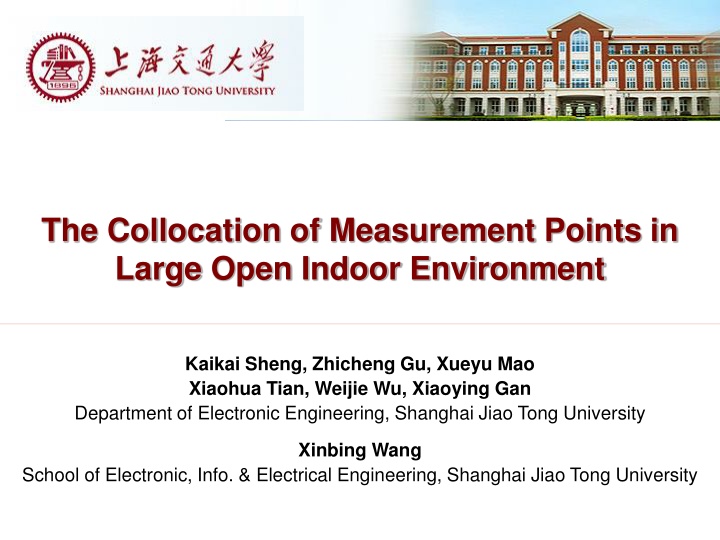
Measurement Points Collocation in Large Open Indoor Environments
Explore the collocation of measurement points in large open indoor environments for accurate indoor localization using signal strength fingerprints. Overcoming challenges such as fingerprint similarity and computational complexity, the study focuses on expected quantization location error (EQLE) and neighboring regions and triangles.
Download Presentation

Please find below an Image/Link to download the presentation.
The content on the website is provided AS IS for your information and personal use only. It may not be sold, licensed, or shared on other websites without obtaining consent from the author. If you encounter any issues during the download, it is possible that the publisher has removed the file from their server.
You are allowed to download the files provided on this website for personal or commercial use, subject to the condition that they are used lawfully. All files are the property of their respective owners.
The content on the website is provided AS IS for your information and personal use only. It may not be sold, licensed, or shared on other websites without obtaining consent from the author.
E N D
Presentation Transcript
The Collocation of Measurement Points in Large Open Indoor Environment Kaikai Sheng, Zhicheng Gu, Xueyu Mao Xiaohua Tian, Weijie Wu, Xiaoying Gan Department of Electronic Engineering, Shanghai Jiao Tong University Xinbing Wang School of Electronic, Info. & Electrical Engineering, Shanghai Jiao Tong University
Outline Introduction Introduction Background Motivation Metrics & Definitions Metrics & Definitions Two Preliminary Cases Two Preliminary Cases General Case General Case Summary Summary 2
Background Indoor localization cannot be addressed by GPS due to large attenuation factor of electromagnetic wave. Traditional localization techniques use Infrared, RF or ultrasound. 3
Background With the pervasion of smartphones and Wi-Fi Access Points (APs), the received signal strength (RSS) fingerprint based method is the most popular solution. Collect location fingerprints in each measurement point. Estimate the user location by matching user s RSS vector with fingerprint library. 4
Motivation Large open indoor environment Large indoor area & high population density Sparse indoor obstacles Challenges Fingerprint Similarity Computation Complexity Budget Constraint 5
Outline Introduction Introduction Metrics & Definitions Metrics & Definitions EQLE Neighboring region Neighboring triangle Two Preliminary Cases Two Preliminary Cases General Case General Case Summary Summary 6
EQLE Expected quantization location error (EQLE): expected (average) distance error from the user actual location to the nearest measurement point. 7
Neighboring region & triangle Neighboring region: the region which M is the nearest measurement point to any user located in. Neighboring triangle: the triangle combined by three measurement points with no other measurement points in. 8
Outline Introduction Introduction Metrics Metrics & & Definitions Definitions Two Two P Preliminary reliminary C Cases Regular Collocation Random Collocation ases General Case General Case Summary Summary 9
Regular Collocation Definition of regular measurement points are at the intersecting locations of a mesh network that two groups of parallel lines with the various spacing intersect at a certain angle. Generalize 10
Regular Collocation Assumption & Approximation Users are uniformly distributed. There is no obstacle and the whole region is accessible to people and measurement points. Ignore the effect of measurement points at the region boundary. 11
Regular Collocation EQLE, MQLE can be minimized when measurement points are collocated as follow. The distance of nearest neighboring measurement points (DNN) can be maximized when measurement points are collocated as follow. 12
Regular Collocation Comparison of collocation patterns VS EQLE MQLE DNN Equilateral triangles Grids 0.377 ? ? 0.620 ? ? 1.075 ? ? 0.383 ? ? 0.707 ? ? ? ? 13
Regular Collocation Simulation results Theoretical No obstacles Obstacles Equilateral triangles Grids 0.011810 0.011810 0.011997 0.011956 0.011955 0.012185 14
Random Collocation Assumption & Approximation Users are uniformly distributed. Measurement points are uniformly randomly collocated 15
Random Collocation ( ) 1 !! + 2 N !! N S EQLE is lower bounded by , this bound becomes ( 2 ) tight when point numberis large. ( ) 1 !! + 2 !! N 1 2 S S N = lim N S Actually, . ( 2 N 1 2 N ) Hence, can be regarded as the approximate value for the EQLE of this region when N is large. 16
Random Collocation Simulation results Comparisons Triangles Grids Random EQLE 0.377 ? ? 0.383 ? ? > 0.5 ? ? 17
Outline Introduction Introduction Metrics Metrics & & Definitions Definitions Two Two Preliminary Preliminary Cases Cases General Case General Case Challenge & Model Theoretical Results Simulation Summary Summary 18
Challenge & Model Challenge User density varies in different parts of the region. Model The p.d.f. of user in different parts of region denoted by is respectively. 1 2 , , , l , , , S S S 1 2 l / c S N In each part, the EQLE is . i i i Triangles Grids Random EQLE 0.377 ? ? 0.383 ? ? > 0.5 ? ? 19
Theoretical Results Using Holder s Inequality, EQLE of the whole region is minimized when ( ) ( ) ( ) 2/3 2/3 2/3 S c S c S c = = = 1 1 1 2 2 N 2 l l l . 1 N N 2 l Defining measurement point density as N S = . ( ) 2/3 c u EQLE can be minimized when . i i i As a special case, if collocation pattern in each part is 2/3 i u identical, EQLE can be minimized when . i 20
Simulation Testbed = = 0.1 0.9 2 1 S S 2 1 1 2 rectangular region Allocate measurement points following . i i 21
Outline Introduction Introduction Metrics Metrics & & Definitions Definitions Two Two Preliminary Preliminary Cases Cases General Case General Case Summary Summary Conclusion More Applications 22
Conclusion Two preliminary cases If measurement points are collocated regularly, equilateral triangle pattern can minimize EQLE and MQLE while maximize DNN. If the measurement points are collocated randomly, EQLE has a tight lower bound. General case ( ) 2/3 c u EQLE can be minimized when . i i i Choose collocation pattern considering deployment budget, target localization accuracy in each part. 23






















